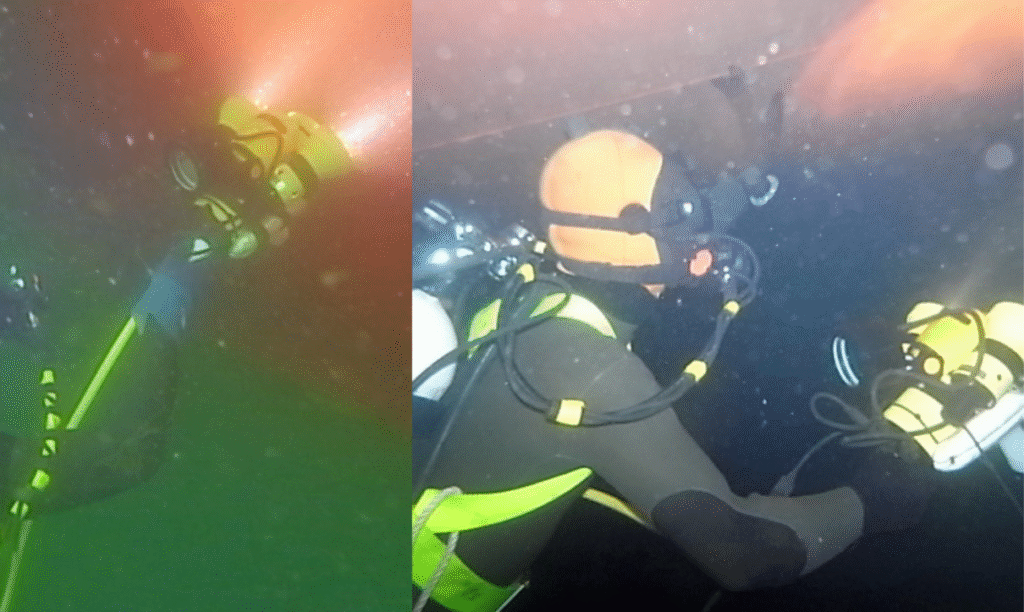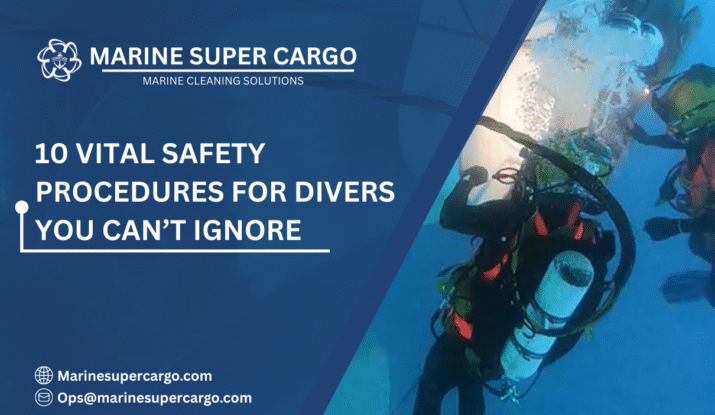When we think of divers, we often imagine calm professionals gliding beneath the waves, working on hull inspections, cleaning surfaces, or making vital repairs. Yet behind this serene picture lies a dangerous reality. Without proper safety procedures for divers, even the smallest mistake can turn into a life-threatening situation.
This guide walks you through everything you need to know about protecting divers and their crews. We’ll explore real examples, practical procedures, compliance requirements, and even future innovations. Whether you’re a ship owner, operator, or managing crew, this article equips you with tools to make diving operations safer and more efficient.
Why Safety Procedures for Divers Matter
The ocean is unpredictable, and diving exposes individuals to risks found nowhere else. Following strict safety procedures for divers:
- Protects human lives, the most valuable resource.
- Prevents accidents that lead to costly downtime and penalties.
- Ensures compliance with international standards such as IMCA guidelines, IMO conventions, and MARPOL Convention.
- Builds confidence in crews, clients, and insurers.
- Protects vessel owners from liability.
Think of diving safety as the ship’s rudder—it doesn’t make the vessel move, but without it, you risk drifting into disaster.

Core Principles of Diving Safety
Every professional dive plan must integrate essential principles to guard against hazards:
- Preparation: Careful pre-dive planning, including hazard assessments.
- Fitness to Dive: Ensuring divers are medically fit, rested, and trained.
- Equipment Reliability: Certified, tested, and well-maintained gear.
- Communication: Clear signals, audio links, and backup communication systems.
- Emergency Readiness: Safety divers, oxygen kits, and decompression chambers on standby.
By embedding these principles in daily operations, you transform safety from a checklist into a culture. Also, read about the underwater hull cleaning in Australia.
Essential Safety Procedures for Divers
To create an effective routine, it’s vital to standardize processes that prevent failure at every stage. The following are critical safety procedures for divers, applied worldwide in commercial and ship-support operations:
1. Pre-Dive Risk Assessment and Briefing
A structured discussion before entry reviews potential hazards, emergency roles, and work scope. Everyone knows what to do when things go wrong—before they even get wet.
2. Medical Fitness and Readiness Checks
Every diver must pass a recognized health check and confirm no issues have arisen since the last dive. Fatigue and illness are invisible but deadly threats underwater.
3. Equipment Inspections
From full-face masks to oxygen supply lines, all gear must be tested and logged. A single fault could compromise both diver and crew.
4. Controlled Entry and Descent
Rushing underwater often leads to miscommunication or accidents. Controlled descents with comms checks reduce risks.
5. Continuous Monitoring
The surface team tracks divers’ depth, air supply, work cycles, and behavior constantly. Monitoring prevents overheating, panic, or exhaustion from escalating.
6. Air Quality and Supply Management
Compressed air systems must be clean and tested against contaminants like carbon monoxide. Divers also require reliable backup sources.
7. Emergency Procedures
Always maintain a ready standby diver, oxygen kit, rescue equipment, and pre-rehearsed protocols. Emergencies cannot be improvised underwater.
8. Controlled Decompression and Ascent
Skipping decompression procedures leads to decompression illness, also called “the bends”. Stepwise ascents and chamber access are mandatory.
9. Debriefing and Documentation
Every dive ends with a review to capture lessons, log events, and improve the next operation. This feedback cycle strengthens safety resilience.
Common Diving Hazards and Controls
Commercial divers and their crews face unique hazards daily. Here’s a snapshot:
- Decompression Illness → Mitigate with accurate dive tables and chamber facilities.
- Loss of Communication → Redundant audio systems and rope signals.
- Entanglement in Nets or Hull Fouling → Sharp cutting tools, buddy procedures.
- Marine Life Hazards → Awareness training, avoidance techniques.
- Contaminated Waters → Surface-supplied helmets, MARPOL-compliant waste handling.
- Equipment Failure → Multiple backups and strict inspection checklists.
The takeaway? Hazards don’t vanish, but safety procedures for divers minimize—and often neutralize—their impact.
Crew’s Role in Diving Safety
Safety is not exclusively a diver’s responsibility. Crew members are critical:
- Masters & Officers ensure ship stability and compliance during underwater work.
- Deck Crew set up equipment, handled lines, and maintained the diver watch.
- Engineers manage compressors, air cylinders, and life-support tech.
- Safety Officers evaluate risks in real-time and have the authority to halt unsafe work.
By sharing accountability, you prevent blind spots and spread safety responsibility across all operations.
Compliance and Legal Requirements
Operating without compliance is like sailing without charts—dangerous and costly. Among the most relevant frameworks:
- IMCA Guidelines define best practices for offshore diving operations.
- IMO conventions ensure safety management at sea.
- MARPOL Convention safeguards the marine environment during hull-cleaning and underwater maintenance.
- IAPH guidance supports safe operations in ports globally.
These frameworks aren’t red tape—they are shields protecting divers, vessels, and oceans alike.
Real Story: The Cost of Skipping Safety
During a hull-cleaning project in a busy port, a team skipped a full equipment inspection to save time. A diver’s air supply hose had a minor crack that was ignored. Minutes into the dive, the supply faltered. Luckily, a backup diver intervened—but the scare rattled the entire crew.
Here lies the truth: the price of skipping safety procedures for divers is far higher than the time it would have taken to follow them.
🌊✨ Client Testimonial Spotlight ✨🌊
— Marine Super Cargo (@Marinsupercargo) September 16, 2025
💬 “The team at Marine Super Cargo feels like part of our crew. From hold cleaning to supercargo support, they handle everything seamlessly. Their quick response and reliable service saved us valuable time and money.” – Mr. Ingmar Domrös pic.twitter.com/bPlooKOakt
Innovations Shaping Future Safety
The sea industry is evolving, and so are diving safety procedures for divers:
- Biometric Monitoring: Devices track divers’ heartbeat, stress, and oxygen in real time.
- ROVs (Remotely Operated Vehicles): Reduce human exposure to high-risk tasks like deep-hull inspections.
- AI-based Analytics: Predict hazards like current shifts or sudden weather changes.
- Green Technologies: Align hull-cleaning methods with MARPOL requirements for sustainability.
By leveraging technology, we can move from reactive safety to predictive safety.

Practical Safety Tips for Operators
- Treat procedures as a constant practice, not just paperwork.
- Encourage open reporting of hazards without blame.
- Train divers and crew together—safety is a shared discipline.
- Build in redundancy; two systems are better than one under pressure.
- Regularly review compliance to stay audit-ready.
Think of safety as your anchor: without it, no ship or operation remains steady.
Conclusion
Safety at sea depends on strict adherence to safety procedures for divers. The three key points to remember are:
- Proper preparation and procedures prevent accidents.
- Crew involvement is essential for comprehensive safety.
- Compliance with IMCA, IMO, and MARPOL protects life and the marine environment.
Taking shortcuts is never worth the risk. For professional, sustainable, and safe operations, partner with experts like CleanShip.co who advocate safety and compliance at every stage.
FAQs:
Q1. What are the most important safety procedures for divers?
Pre-dive briefings, equipment checks, emergency readiness, continuous monitoring, and decompression controls are most vital to prevent accidents.
Q2. How do safety procedures for divers save costs?
They prevent accidents, downtime, insurance claims, and penalties—making compliance not only safe but financially smart.
Q3. Who sets global diving safety standards?
Organizations like IMCA, IMO, and MARPOL set frameworks, while port authorities like IAPH enforce regional compliance.
Q4. How do divers and crew prepare for emergencies?
Through pre-planned drills, standby divers, oxygen availability, and rescue rehearsals during surface briefings.
Q5. Will technology replace divers entirely in the future?
Not completely. While ROVs and AI reduce direct exposure, divers remain essential for complex repairs and inspections, with tech serving as a safety shield.


